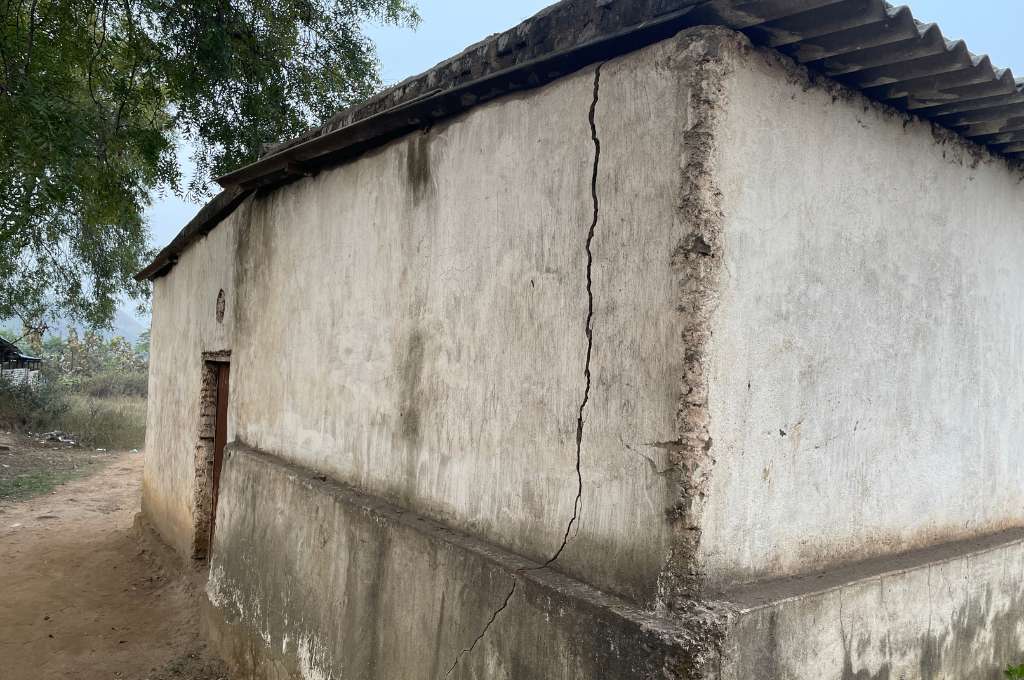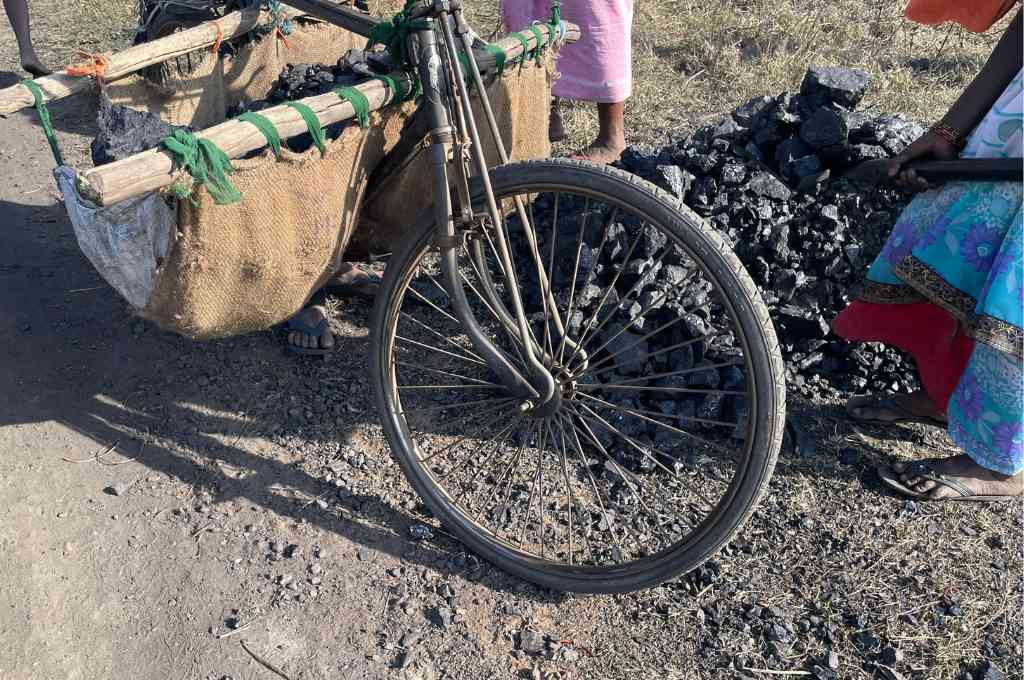
Across 10 villages in the coal-dependent districts of Jharkhand and Chhattisgarh, the global language for just transitions falters. The idea of using economic diversification, alternative jobs, retraining, and reskilling loses its shine. In most parts of the world, the conversation revolves around creating substitute livelihood options for those affected by the phasing out of fossil fuels. However, in Hazaribagh, Korba, Raigarh, and Ramgarh, locals are preoccupied with land: its loss to mining, their fight to retain it, and their dream to regain it. Those living in the shadow of the coal-mining sector say that they don’t trust jobs as only a few of them are formally or consistently engaged with the coal economy. This is one of the reasons that keeps them focused on issues of land ownership.
Mahuatand, a Santhal village in Ramgarh district, Jharkhand, is an example of what the closure of coal mining can set off in rural communities around mines. With the first energy transition—when a public sector undertaking (PSU) set up its mine in the 1980s—residents lost their agricultural land and, hence, their generational wealth and food security. They became almost entirely dependent on the coal job economy. The jobs are few. While the handful of employees still continue to receive their salary, this source may soon run its course as the mine shut down in 2019.
Bablu Hembrom, who fought for a job with the mining company and finally secured it in 2016, goes in daily to mark his attendance. Father of two, Bablu knows the future is uncertain for the younger residents of the remote village. “Most of us regret the decision our parents or grandparents took in 1964 to swap agricultural land for compensation or jobs. Coal mining started in 1984. The money we received as compensation has run out for many of us. Jobs came to only one person in each family. That will also not last. In the future, we will end up as beggars,” he says. According to Sarpanch Kiran Devi, approximately 75 percent of the population here is unemployed. “Working-age adults, even when they have education and degrees, are financially dependent on their parents.” Biju Oraon adds, “Even if other industries develop, will there be enough jobs for all of us?” It doesn’t help that, so far, the growth of renewable energy is concentrated in some southern and western states.
In Chhattisgarh, Shivpal Bhagat, who belongs to the Oraon community and is the sarpanch of Kosampali village, Raigarh, tells us that his family has lived in the area for four generations but they have never known such financial insecurity before. He says, “We have been floundering since we gave up our land in 2007. We were expecting development and thought we would get stable employment. Instead, only a few of us get jobs, that too of lower grades, and with contractors.” His brother Kuldeep Bhagat pitches in, “When our parents sold the land, they were not equipped with the necessary information or understanding.”

Land should be returned to the indigenous people or the farmers who originally owned it. Picture courtesy: International Accountability Project / CC BY
A conflicted relationship with coal
On the one hand, mining activity is increasing: India opened 22 new coal mines between 2015 and 2022, and has another 93 proposed coal projects. On the other, employment in the coal sector has not seen growth. The use of mechanisation, private contractors, and mine development operators (MDOs) has resulted in fewer and more informal engagements. By some estimates, the number of contractual and informal workers in the sector is 2.4 times that of formal workers.
Some residents allege that contractors and MDOs prefer people from other states, often their own, for most of the work. Migrants are put up in camps inside the mines and work daily for a few months, they add. “They believe we take too many leave days and prefer the migrants who are available at all times,” alleges a local employee.
Most locals working in the coal sector seem to have a conflicted relationship with it. Two men from Churchu in Hazaribagh, Jharkhand, say they are grateful for the jobs they secured as compensation for their ancestral land. However, requesting anonymity, both allege they get their payslips from different companies every couple of months. They are confused about who they are employed with and wonder what the terms will be if they are laid off and whether they will be compensated. In Sarasmal village, a guard now hired by a contractor reports that he was laid off from his cleaning job with the mining company as one of his eyes was deemed weak after a medical examination. In Tapranga, Raigarh, union leaders for local employees tell us they would be devastated to lose their jobs but complain about how houses crack or break because the mine is too close to their colony.
In Bhujangkachar, located on the precipice of a mine in Korba district, Chhattisgarh, Bhagwan Das* who lost his agricultural land to mining, is worried that the excavation is now moving closer to his house. His son Shyam Das,* who lives with him, has a contractual job with the very company about to take over the land where his house stands. Many of his peers live with this ambiguity. One of them, Ransahi Sonpakat, says he prefers to hedge his bets for the future. “I would like to continue farming the land I have remaining, even if it is not as much as before. My children may get a job. If not, it is important to have land so they can use it for agriculture later,” he says.

Houses crack or break because the mine is too close to the colony. | Picture courtesy: Debojit Dutta
No land, no food security
Approximately 42 percent of the population in Jharkhand and about 29 percent in Chhattisgarh is multidimensionally poor. Most locals equate land ownership with food security. “We always had food when we had our own land. Now we need to pay for everything. The salary is not adequate for that,” says Ram Sewak Badal, who lives in a rehabilitation colony in Dhenga, Jharkhand.
In Sarasmal, Bhagwati Bhagat, 60, says she used to run her house on mahua, tendu, and other forest pickings. “I worked for six months and that was enough to feed my family for the whole year. There is such little forest produce now. On top of that, to get to the forest, I walk across the mine. It is steep and dangerous. We used to eat so much moringa (drumstick) earlier. Now it is covered in soot, and we need to wash it many times before we can cook it.” Local women who worked as agricultural labour or made a livelihood from forest produce are deeply affected by coal-related displacement.
In Mahuatand, many migrate to other regions and states for sustenance. Others, however, succumb to the informal coal-gathering economy. A queue of women and adolescents climb down a precarious dirt path into the valley, mobiles in their hand so they can use them as torches. People with a smaller build fare better in the dark underground mine. The company has made a trench around the abandoned mine to prevent them from going in. But the coal gatherers have broken a passage through it. Ram Manjhi* says, “If I don’t collect and sell this coal, we won’t be able to cook dinner. If the coal is carried out in trucks, it’s development. But if we carry it out on our bicycles and motorcycles, that’s stealing.” One of the many people displaced by mining, Manjhi received neither compensation nor a job. After he vacated his house, he moved closer to the forest. He alleges forest officials filed a case against him for encroachment on forest land.

Locals are aware that the coal industry can’t be sustained for long and that they may lose their land for nothing. | Picture courtesy: Debojit Dutta
Land is critical for survival
Rural communities currently facing land acquisition by newer mining projects have learned from the history of ‘coal’ villages. In villages such as Jugra, Jharkhand, and Pelma, Chhattisgarh, locals persistently protest displacement. Chunnulal Soren, an Ekta Parishad activist from Vishnugarh, Jharkhand, says locals are aware that the coal industry can’t be sustained for long and that they may lose their land for nothing.
Sudhlal Saw is a sugarcane farmer in Jugra, Jharkhand, and his family of two sons, daughters-in-law, and grandchildren work together to produce jaggery. He says, “I refuse to convert my generational wealth to money. It will turn us from masters of our land to servants elsewhere. Look at what is happening all around. Will they give jobs to all of us for every generation?” Kailash Saw, an activist in the village, points out the folly in using fertile land for excavations. “Barkagaon (the village he lives in) is part of what is known as the rice bowl of the region. Why are we using this land for mining?”
Ramdular Saw, a schoolteacher in Jugra, says, “Why are they acquiring land now if they have to close down the mine in three or four decades? History has taught us not to give up our land for short-term gains.” In 2018, the residents of Jugra complained to the district administration that land was being acquired forcefully from them.
In Chhattisgarh, locals have been protesting industrial mining with a coal satyagraha since 2011. In Pelma, Chhatisgarh, there is a near consensus that mining won’t change their fortunes for the better but for the worse. Rajbala*, a resident of Pelma, believes it will be disastrous to give up her land. “It will be a big loss. I want my children to stay here and continue with agriculture.”
Shivpal Bhagat speaks for most people affected by mining in the region when he says that jobs in future industries will not be enough to secure their sustenance. “Agricultural land is critical to our survival,” he says. Shivpal was among the petitioners who sought environmental damages from a mining company for failing to, among other things, remedy the topsoil they had destroyed. He says that mining companies should follow the law and level the land when they are done, restoring the topsoil so it can be reused for the benefit of local communities. Union leaders at Tapranga say that even infertile land will help as locals can use it for fishery, animal husbandry, and other livelihood options.
However, India lacks the legal framework necessary to facilitate the transfer of land back to the communities. Ramesh Sharma, national coordinator at Ekta Parishad, says, “Once the government has taken the land for mining, it can transfer this land to another project or lease it to a private company. Even if renewable energy grows, private companies will get large tracts of land to run solar or wind farms. But land should be returned to the indigenous people or the farmers who originally owned it. It can be co-owned by communities.”
Approximately 120 districts in the country have sizeable fossil-fuel or related industries and they have one-fourth of the country’s population. For a just transition, India may need to consider a strategy appropriate to the needs of affected locals, and these needs are rooted in land.
*Names changed to maintain confidentiality.
This article was originally published on India Development Review.





